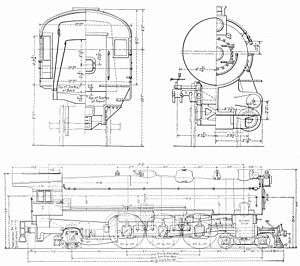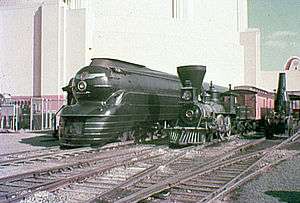PRR K4s
|
A K4s-hauled train pauses at Aberdeen, Maryland on 1944-04-26. This is the classic prewar K4s configuration. | |||||||||||||||||||||||||||||||
| |||||||||||||||||||||||||||||||
| |||||||||||||||||||||||||||||||
| |||||||||||||||||||||||||||||||
| |||||||||||||||||||||||||||||||



The Pennsylvania Railroad's K4s 4-6-2 "Pacific" (425 built 1914–1928, PRR Altoona, Baldwin) was their premier passenger-hauling steam locomotive from 1914 through the end of steam on the PRR in 1957.
Attempts were made to replace the K4s, including the K5 and the T1 duplex locomotive, but none was really successful, and the K4s hauled the vast majority of express passenger trains until replaced by diesel locomotives. The K4s was not powerful enough for the heavier trains it often pulled from the mid-1930s onward, so they were often double or even triple headed. This was effective, but expensive—several crews were needed. The PRR did have the extra locomotives, many having been displaced by electrification.
It is recognized as the State Steam Locomotive of Pennsylvania. On December 18, 1987, Pennsylvania Governor Robert P. Casey signed into law House Bill No. 1211 naming the PRR K4 as the “official” state locomotive, according that title to both K4 survivors, 1361 and 3750.
Development
The K4s was designed under the supervision of PRR Chief of Motive Power J.T. Wallis, assisted by Chief Mechanical Engineer Alfred W. Gibbs and Mechanical Engineer Axel Vogt, as one of a pair of classes with the L1s 2-8-2 "Mikado", sharing a boiler and other features. Some inspiration came from the large experimental K29s Pacific built in 1911 by the American Locomotive Company. Also influential was Gibbs' design for the successful E6 4-4-2 "Atlantics", from which the K4s inherited its heat-treated, lightweight machinery, its cast-steel KW trailing truck, and much of its appearance.
The K4s design increased grate area from previous classes' 55 to 70 sq ft (5.1 to 6.5 m2). The boiler barrel was fatter than previous classes, and the increase in heating surface and boiler size gave the class good steam-generating capability. Equipment on the prototype, built in 1914, was conservative and included a screw reverse (power reverse would soon be added), a small 70-P-70 tender holding only 7,000 US gallons (26,000 l) of water and 12½ tons of coal set up for hand firing, a wooden cowcatcher pilot, a square-cased, old-fashioned headlight and piston tailrods (soon to go).
The K4s design was successful enough that it influenced other locomotive designs, and not only those of other PRR locomotives. London and North Eastern Railway Chief Mechanical Engineer Nigel Gresley incorporated much of the boiler design (including the tapered shape) into his famous Class A1 Pacific.[1]
A World War I era prototype had distinctive "chicken coop" slat pilots, while the Post-War versions had modern pilots.
Production
Three years elapsed until production examples were built. Partly, this was due to extensive testing, but wartime necessitated priority in construction to the L1s Mikado type for freight. In 1917 Altoona's Juniata Shops started producing K4s in numbers. The first 168 carried widely scattered road numbers as traditional for the PRR, but subsequent locomotives produced after 1920 were numbered in consecutive blocks.
| Year | Quantity | Road numbers |
|---|---|---|
| 1914 | 1 | 1737 |
| 1917 | 41 | assorted numbers |
| 1918 | 111 | 3667–3684, 5334–5349, plus assorted numbers |
| 1919 | 15 | assorted numbers for PRR Lines West |
| 1920 | 50 | 3726–3775 |
| 1923 | 57 | 3800, 3801, 3805–3807, 3838–3889 |
| 1924 | 50 | 5350–5399 |
| 1927 | 92 | 5400–5491 |
| 1928 | 8 | 5492–5499 |
Numbers 5400–5474 were built by Baldwin, while all others were constructed at the PRR's Juniata Shops.
Modifications
The PRR experimented extensively with its K4s fleet, trying out streamlining, poppet valves, smoke deflectors, driving wheel types and others.
Streamlining
A number of K4s locomotives had streamlining applied over the years, to varying degrees. All were later removed, restoring the locomotives to their original appearance.
3768

Locomotive #3768 was clad in a shroud designed by famed industrial designer Raymond Loewy in February 1936. This was a very concealing, enveloping streamlined casing which hid most of the functionality of the steam locomotive, leading to its nickname of "The Torpedo" by train crews. At first, the locomotive was not painted in standard Dark Green Locomotive Enamel (DGLE) but instead in a bronze color. It was later refinished in DGLE. A matching tender ran on unusual six-wheel trucks. Like most streamlined steam locomotives, the shrouds impeded maintenance and the covers over the wheels were later removed. For a time, the locomotive was the preferred engine for the Broadway Limited.
The 3768 can be seen in action in the 1945 film, The Great Flamarion.
The 3768 renumbered as 3763 can be seen in the film Broadway Limited (film).
1120, 2665, 3678, and 5338

These four locomotives were streamlined in 1940 and 1941 with simpler, closer-fitting casings that hid less of the steam locomotives' workings; in that sense, they were similar to Henry Dreyfuss's casings for NYC Hudsons.

1188
K4s #1188 was given a boiler-top streamlined "skyline" casing, but no other streamlining, and was nicknamed "The Skyline".
Other Modifications
5484
K4s 5484 was refitted with cross-counterbalanced disc drivers.
5038
K4s 5038 was given "elephant ear" smoke deflectors and a shroud for the smokestack.
Boosters
K4s numbers 3676, 5399, and 5436 were fitted with booster engines on the trailing trucks in 1941.
Roller Bearings
K4s numbers 20 and 5371 were fitted with roller bearings.
Poppet Valves
K4s 5399 was rebuilt by Lima in 1939, with, among other improvements, poppet valves actuated by Franklin oscillating cams. K4s 5436 was fitted with stem actuated valves in 1940. They were designed by Lloyd Jones, the Engineer of tests at the Altoona Works. in 1945, K4s 3847 was given a front-end throttle and Franklin rotary-actuated poppet valves. All performed well, but were difficult to maintain.
K4sa
K4s numbers 612, 1985, 5405, 5481 and 5484 were converted with 15" piston valves, higher steam domes and circulators, and front-end throttles.
Preservation
There are only two surviving K4s class locomotives. Number 3750 is on display at the Railroad Museum of Pennsylvania in Strasburg. Number 1361 was set to be restored to operation by the Railroaders Memorial Museum in Altoona through the restoration shop at Steamtown National Historic Site. However, due to the difficulty of overseeing the work, Altoona has halted the restoration until their restoration shop is completed. As of 2008, 1361 is sitting in pieces in a corner of Steamtown's roundhouse. In 2010, the Railroaders Memorial Museum announced that the restoration was to be canceled, and the engine, when it arrives at the museum, would be reassembled and receive only a cosmetic restoration.[2] At that time, most of the restoration was completed save for that of the boiler and other components, so it is possible that the museum may resume the restoration to operating condition in the future.
Despite the publication in the paper, museum personnel have stated though the cosmetic restoration idea was discussed, it is still museum intention to restore the engine to operating status. With the announcement of NS restarting its own steam program, there also exists, at least a little hope, of a future with a K4 under steam on the high iron.
In fiction
- The Thomas and Friends character Hank is based on the K4. In the 2016 special, Thomas & Friends: The Great Race. Gordon was streamlined in hopes that he would win in the racing competition. The casing appeared to be based on the Loewy design.
In Video Games
The K4 Pennsy Pacific is featured on the box art of Railroad Tycoon 3.
References
External links
- The Pennsylvania Railroad Pacifics at SteamLocomotive.com.
- PRR Steam Roster Pt6 - Class K.
- K4s - All of them! by Gary Mittner.
- Digital PRR K4 for N3V Trainz Simulator By Bill Klene & Steve Lerro
| Wikimedia Commons has media related to Pennsylvania Railroad K4s. |
